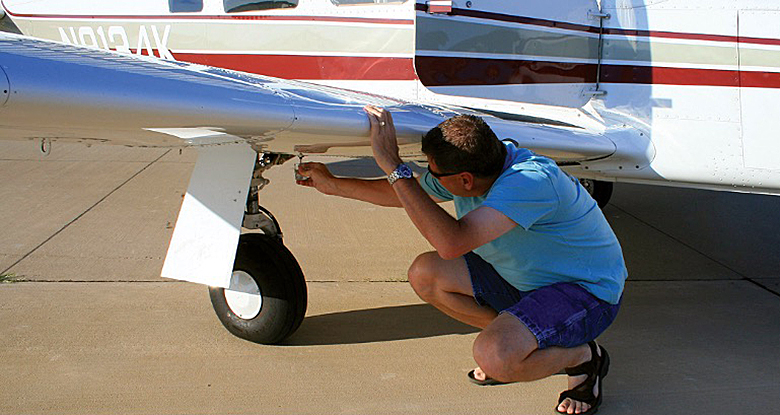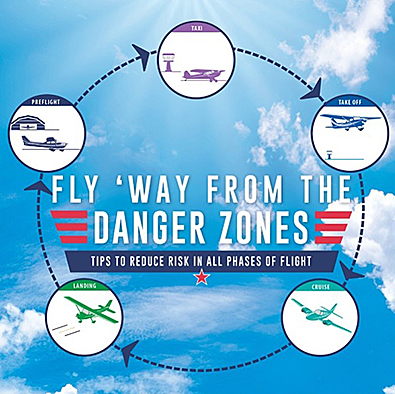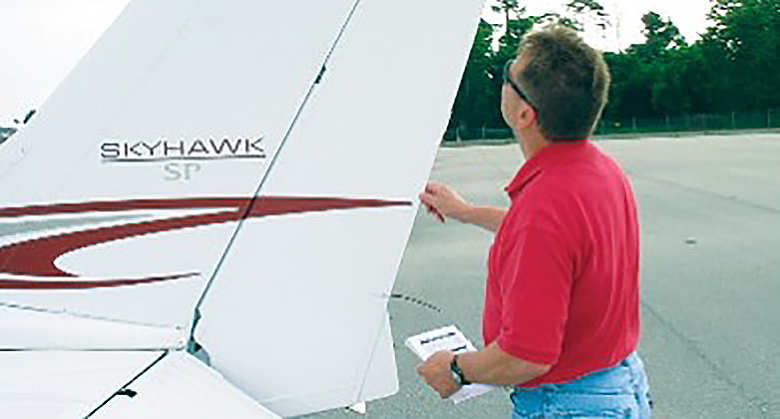Tips for Perfect Preflight Prep
Why Better Preflight Preparation is Paramount to Safe Flight
By Paul Cianciolo, FAA Safety Briefing Magazine Associate Editor

Inadequate preflight preparation is cited as a contributing factor in many general aviation accidents. Even something as simple as a loose fuel cap missed during a preflight inspection can cause chaos. That happened to a student pilot in 2011 during a Robinson R22 helicopter training flight. The fuel cap came off during an autorotation maneuver and sliced off part of the tail rotor. The aircraft ended up on its side, but at least the pilots escaped with minor bruises. Not all accidents have this kind of happy ending.
As the pilot-in-command (PIC), it’s your responsibility to determine if the aircraft you are about to fly is airworthy and safe for flight. Knowing if you are fit for flight as the pilot is just as important. You can prepare yourself for better preflight performance with these recommended practices.

Make a Plan
Flight planning is the most important phase of any flight activity as it sets the stage for the entire flight. Review your planned route and look for any unique navigation equipment requirements that may be needed. Double-check temporary flight restrictions (TFRs) and special use airspace along your route. Consider alternate plans if the weather bubbles up.
Once you know your aircraft’s load of people and things, review the performance for that flight to make sure you are within the center of gravity limits. This gives you time to adjust and reposition if your weight and balance is not within limits. Make sure you are able to meet climb gradient and terrain restrictions based on your aircraft’s performance capabilities.
Another potential pitfall is not considering task management. Are you flying alone or with another pilot? If you’re flying with another pilot, it’s important to be very clear about how you’ll split tasks in the cockpit and the specific process and terms used for exchanging control of the aircraft (e.g., “You have the flight controls.” “I have the flight controls.”) before getting airborne. Read up on crew resource management (CRM). Without clear communication from the very beginning, it won’t be smooth sailing.
If you are flying by yourself, read up on single-pilot resource management (SRM).
Then there’s you. In addition to the legal limits of your flight, consider your personal minimums too. Don’t risk flying outside of what you are comfortable with. If the ceiling drops, how low will you go before diverting or landing? How well do you know how to interpret weather information and make operational decisions based on that?
Having weather information available is only part of the weather decision-making equation. Knowing how to acquire, interpret, and make operational decisions based on weather information is essential to safe flying. Read about available weather information sources and get guidance on making well-informed weather decisions.
Also check out the Advisory Circular 91–92, Pilot’s Guide to a Preflight Briefing. It provides an educational roadmap for the development and implementation of preflight self-briefings, including planning, weather interpretation, and risk identification/mitigation skills. There are also two preflight self-briefing courses available at FAASafety.gov that earn WINGS credit.
- WINGS Course ALC-683, Conducting Preflight Self-Briefings for Student and VFR Pilots
- WINGSCourse ALC-889, Conducting Preflight Self-Briefings for IFR Pilots
Another great way to preflight your go/no-go decision is to score yourself and your flight using a flight risk assessment tool (FRAT) on an app or worksheet. The FAA Safety Team’s (FAASTeam) GA-focused FRAT is available as an automated spreadsheet at bit.ly/FAASTeamFRAT. It’s based on the PAVE checklist explained in the next section. A FRAT enables proactive hazard identification, is easy to use, and can visually depict risk. It is an invaluable tool in helping pilots enhance their aeronautical decision-making skills and should be a part of every flight.
A flight risk assessment tool (FRAT) enables proactive hazard identification, is easy to use, and can visually depict risk.
Always Use Checklists
Preflight checklists are essential to a safe flight — use them. As mentioned above, a good FRAT is based on the mnemonic PAVE. By incorporating the PAVE checklist into preflight planning, you divide the risks of flight into four categories:
✔️ Pilot
✔️ Aircraft
✔️ enVironment
✔️ External Pressures
Dive deep into each category by clicking on the links above.
You can also download and print a PAVE checklist at bit.ly/3qRBpjG.
Another mnemonic that expands on the Pilot in PAVE is the I’M SAFE checklist to determine your own fitness to fly.
✔️ Illness
✔️ Medication
✔️ Stress
✔️ Alcohol
✔️ Fatigue
✔️ Emotion/Eating
Several factors can affect your ability to fly safely. Something as common as an antihistamine can have an unintended consequence — in fact, sedating antihistamines are the most commonly detected medication in fatal accidents. Before your next flight, study up on avoiding adverse drug interactions. This may surprise you.
Once you are good to go, it’s time to preflight your aircraft. That means the aircraft must be legally airworthy and in a condition for safe flight. To determine if you are airworthy, use the ARROW checklist mnemonic.
✔️ Airworthiness Certificate
✔️ Registration Certificate
✔️ Radio Station License (international only)
✔️ Operating Limitations
✔️ Weight and Balance
Read the first chapter of the FAA’s Plane Sense handbook (FAA-H-8083–19A) for more details about the ARROW checklist.
As a safety-minded pilot, make use of a preflight checklist. Never work from memory to ensure that you do not skip or misevaluate the items you are checking. Use the preflight checklist in the airplane flight manual (AFM) and/or pilot operating handbook (POH) as it contains operating procedures and limitations specific to that make and model aircraft. You can also add your own items to your preflight checklists — like items you have missed in the past or are something to watch, aftermarket safety equipment, any airframe modifications, ADS-B procedures, and any red flags from your mechanic. Watch this video about supplemental checklists for aftermarket safety equipment.
https://www.youtube.com/watch?v=6i8l7Nup5Hw
Enhance Your Preflight Inspection
To better prepare for the preflight inspection, consider building a preflight kit. Ensure that you have the most current preflight checklist. Make sure you have a working flashlight that is not your cell phone light. Include any special tools needed like a fuel sampler, step ladder, safety glasses, or a screwdriver.
Get-there-itis can also affect your preflight performance. That means don’t rush your preflight inspection. Plan ahead and consider proper attire to allow adequate time for a thorough inspection in any conditions.
Enforce a preflight “no distraction” policy. Unnecessary conversations, eating and drinking, and using your electronic device can cause you to lose focus and miss a step. Consider leaving your cell phone in the cabin — not in your pocket — until your inspection is complete. If you do get interrupted, go back at least two steps or start from the beginning.

Another tip is to secure your headgear and any personal items sitting on the flight line so they don’t cause a distraction if the wind decides to move them. If you wear a flight suit or jacket with zippered pockets, zip up so nothing falls out.
Ensure that all your tie-downs, covers, locking devices, and any ground handling equipment is removed and securely stowed. Taxiing with a towbar attached is not a good look.
When your feet are not on the ground, use caution even if there is a non-skid surface. Make sure to keep three points of contact with the aircraft or ladder when climbing up to inspect.
Use a trusted method to verify the fuel level and correct fuel type. Now that there is supplemental type certificate (STC) approved unleaded avgas alternatives, checking the fuel color is even more important. Don’t use the aircraft fuel gauge as the sole measure of quantity. And always check that fuel caps are secure. Just re-read the first paragraph for a good reason why.
If there are rotor blades to check, verify that the blade-tip paths are clear of obstacles. Verbally announce that you are about to move a rotor blade so other people stay clear. Watch this video for more about rotorcraft preflight.
https://www.youtube.com/watch?v=GFc_NIgC_E0&list=PL5vHkqHi51DTAkNwV1ZlHydXxPUCjmiRt
Then, always do one final walk-around before hopping in your aircraft, taking a few steps back to see how the entire aircraft looks. The pilot or trained crew member should always be the last person to board.
Conducting countless preflight inspections can lead to complacency because of its repetitious nature. Discipline yourself to detect subtle changes like a reversed safety wire, broken slippage marks, leaks, etc. If you have any doubt about a component’s airworthiness, check with your mechanic.

Conduct an Advanced Preflight
If you just got your aircraft back from the shop, then conducting an advanced preflight after maintenance is essential. A significant number of fatal accidents could be avoided if pilots were to conduct a more thorough preflight inspection after a return to service. Read more about what it takes for an advanced preflight.
After maintenance, check systems thoroughly (e.g., flight controls move in the proper direction), or ask qualified maintenance personnel to help re-inspect the aircraft to ensure all systems are a go.
Another kind of advanced preflight involves a deep dive into the aircraft’s records. Download the FAASTeam’s M-Pamphlet, Advanced Preflight, for help on how to conduct a complete review of all maintenance-related data on your aircraft, the steps in extracting the valuable information from this data, and how to develop an additional items checklist to be used in conjunction with the aircraft’s preflight checklist for all future preflight inspections.
One last tip is not to ignore service bulletins. Compliance with service bulletins may or may not be mandatory, but you should never ignore them when it comes to safety. Make it a best practice to read, or ask your mechanic to review, any service bulletin that the manufacturer issues for your aircraft. Learn more about service bulletins and their impact on your aircraft.
Rinse and Repeat
We talked about determining the airworthiness of your aircraft, preflight visual inspections, managing risk, and the use of checklists. As the pilot, it’s your responsibility to make sure you and your aircraft are in a safe condition to fly. You are now ready for a perfect preflight prep.
Learn More
- FAA’s Airplane Flying Handbook(Chapter 2)
Paul Cianciolo is an associate editor and the social media lead for FAA Safety Briefing. He is a U.S. Air Force veteran and an auxiliary airman with Civil Air Patrol.
Reprinted with permission from FAA Safety Briefing. Visit the Flight Safety Briefing website: https://www.faa.gov/news/safety_briefing/.



